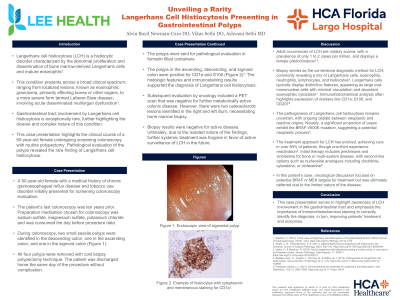Tuesday Poster Session
Category: Colon
P3706 - Unveiling a Rarity: Langerhans Cell Histiocytosis Presenting in Gastrointestinal Polyps
Tuesday, October 29, 2024
10:30 AM - 4:00 PM ET
Location: Exhibit Hall E

Has Audio

Alvin B. Newman-Caro, DO
HCA Florida Blake Hospital
Bradenton, FL
Presenting Author(s)
Alvin B. Newman-Caro, DO1, Vikas Sethi, DO2, Ashwani K. Sethi, MD, MS3
1HCA Florida Blake Hospital, Bradenton, FL; 2HCA Florida Largo Hospital, Largo, FL; 3Lee Health, Fort Myers, FL
Introduction: Langerhans cell histiocytosis (LCH) is a disorder marked by abnormal proliferation and spreading of Langerhans cells and eosinophils from the bone marrow. LCH presents as a wide clinical spectrum, from localized bone or organ lesions to severe multiorgan dysfunction, with gastrointestinal tract involvement being exceedingly rare. This case presentation highlights the clinical course of a 60-year-old female undergoing screening colonoscopy with routine polypectomy. Pathological evaluation of the polyps revealed the rare finding of Langerhans cell histiocytosis.
Case Description/Methods: A 60-year-old female with a medical history of chronic gastroesophageal reflux disease and tobacco use disorder initially presented for screening colonoscopy evaluation. The patient’s last colonoscopy was ten years prior. Preparation medication chosen for colonoscopy was sodium sulfate, magnesium sulfate, potassium chloride and was consumed the day before procedure date. During colonoscopy, two small sessile polyps were identified in the descending colon, one in the ascending colon, and one in the sigmoid colon. All four polyps were removed with cold biopsy polypectomy technique. The patient was discharged home the same day of the procedure without complication.
The polyps were sent for pathological evaluation in formalin filled containers. The polyps in the ascending, descending, and sigmoid colon were positive for CD1a and S100. The histologic features and immunostaining results supported the diagnosis of Langerhans cell histiocytosis. Subsequent evaluation by oncology included a PET scan that was negative for further metabolically active colonic disease. However, there were two osteosclerotic lesions identified in the right and left ilium, necessitating bone marrow biopsy. Biopsy results were negative for active disease. Ultimately, due to the isolated nature of the findings, further systemic treatment was forgone in favor of active surveillance of LCH in the future.
Discussion: This case highlights the rare finding of Langerhans cell histiocytosis involving polyps removed from the large bowel during screening colonoscopy. Due to its rare involvement in the gastrointestinal tract, LCH is scarcely considered in differential diagnoses. This case presentation serves to highlight awareness of LCH's involvement in the gastrointestinal tract and emphasize the importance of immunohistochemical staining to correctly identify the diagnosis, thereby improving patients’ treatment and outcomes.
Disclosures:
Alvin B. Newman-Caro, DO1, Vikas Sethi, DO2, Ashwani K. Sethi, MD, MS3. P3706 - Unveiling a Rarity: Langerhans Cell Histiocytosis Presenting in Gastrointestinal Polyps, ACG 2024 Annual Scientific Meeting Abstracts. Philadelphia, PA: American College of Gastroenterology.
1HCA Florida Blake Hospital, Bradenton, FL; 2HCA Florida Largo Hospital, Largo, FL; 3Lee Health, Fort Myers, FL
Introduction: Langerhans cell histiocytosis (LCH) is a disorder marked by abnormal proliferation and spreading of Langerhans cells and eosinophils from the bone marrow. LCH presents as a wide clinical spectrum, from localized bone or organ lesions to severe multiorgan dysfunction, with gastrointestinal tract involvement being exceedingly rare. This case presentation highlights the clinical course of a 60-year-old female undergoing screening colonoscopy with routine polypectomy. Pathological evaluation of the polyps revealed the rare finding of Langerhans cell histiocytosis.
Case Description/Methods: A 60-year-old female with a medical history of chronic gastroesophageal reflux disease and tobacco use disorder initially presented for screening colonoscopy evaluation. The patient’s last colonoscopy was ten years prior. Preparation medication chosen for colonoscopy was sodium sulfate, magnesium sulfate, potassium chloride and was consumed the day before procedure date. During colonoscopy, two small sessile polyps were identified in the descending colon, one in the ascending colon, and one in the sigmoid colon. All four polyps were removed with cold biopsy polypectomy technique. The patient was discharged home the same day of the procedure without complication.
The polyps were sent for pathological evaluation in formalin filled containers. The polyps in the ascending, descending, and sigmoid colon were positive for CD1a and S100. The histologic features and immunostaining results supported the diagnosis of Langerhans cell histiocytosis. Subsequent evaluation by oncology included a PET scan that was negative for further metabolically active colonic disease. However, there were two osteosclerotic lesions identified in the right and left ilium, necessitating bone marrow biopsy. Biopsy results were negative for active disease. Ultimately, due to the isolated nature of the findings, further systemic treatment was forgone in favor of active surveillance of LCH in the future.
Discussion: This case highlights the rare finding of Langerhans cell histiocytosis involving polyps removed from the large bowel during screening colonoscopy. Due to its rare involvement in the gastrointestinal tract, LCH is scarcely considered in differential diagnoses. This case presentation serves to highlight awareness of LCH's involvement in the gastrointestinal tract and emphasize the importance of immunohistochemical staining to correctly identify the diagnosis, thereby improving patients’ treatment and outcomes.
Disclosures:
Alvin Newman-Caro indicated no relevant financial relationships.
Vikas Sethi indicated no relevant financial relationships.
Ashwani Sethi indicated no relevant financial relationships.
Alvin B. Newman-Caro, DO1, Vikas Sethi, DO2, Ashwani K. Sethi, MD, MS3. P3706 - Unveiling a Rarity: Langerhans Cell Histiocytosis Presenting in Gastrointestinal Polyps, ACG 2024 Annual Scientific Meeting Abstracts. Philadelphia, PA: American College of Gastroenterology.

